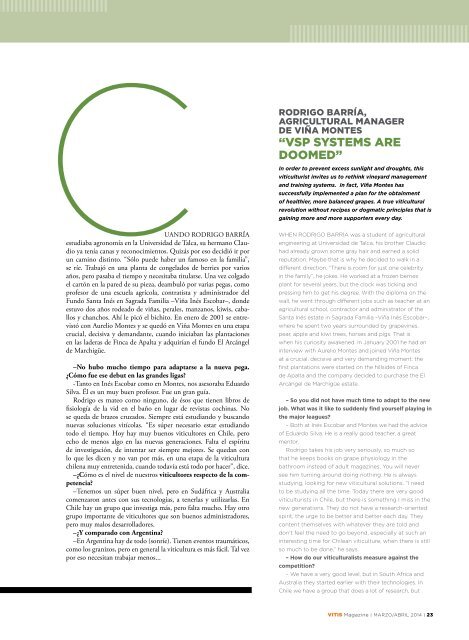rev_57
rev_57
rev_57
Create successful ePaper yourself
Turn your PDF publications into a flip-book with our unique Google optimized e-Paper software.
C<br />
RODRIGO<br />
uando Rodrigo Barría<br />
estudiaba agronomía en la Universidad de Talca, su hermano Claudio<br />
ya tenía canas y reconocimientos. Quizás por eso decidió ir por<br />
un camino distinto. “Sólo puede haber un famoso en la familia”,<br />
se ríe. Trabajó en una planta de congelados de berries por varios<br />
años, pero pasaba el tiempo y necesitaba titularse. Una vez colgado<br />
el cartón en la pared de su pieza, deambuló por varias pegas, como<br />
profesor de una escuela agrícola, contratista y administrador del<br />
Fundo Santa Inés en Sagrada Familia –Viña Inés Escobar–, donde<br />
estuvo dos años rodeado de viñas, perales, manzanos, kiwis, caballos<br />
y chanchos. Ahí le picó el bichito. En enero de 2001 se ent<strong>rev</strong>istó<br />
con Aurelio Montes y se quedó en Viña Montes en una etapa<br />
crucial, decisiva y demandante, cuando iniciaban las plantaciones<br />
en las laderas de Finca de Apalta y adquirían el fundo El Arcángel<br />
de Marchigüe.<br />
–No hubo mucho tiempo para adaptarse a la nueva pega.<br />
¿Cómo fue ese debut en las grandes ligas?<br />
-Tanto en Inés Escobar como en Montes, nos asesoraba Eduardo<br />
Silva. Él es un muy buen profesor. Fue un gran guía.<br />
Rodrigo es mateo como ninguno, de ésos que tienen libros de<br />
fisiología de la vid en el baño en lugar de <strong>rev</strong>istas cochinas. No<br />
se queda de brazos cruzados. Siempre está estudiando y buscando<br />
nuevas soluciones vitícolas. “Es súper necesario estar estudiando<br />
todo el tiempo. Hoy hay muy buenos viticultores en Chile, pero<br />
echo de menos algo en las nuevas generaciones. Falta el espíritu<br />
de investigación, de intentar ser siempre mejores. Se quedan con<br />
lo que les dicen y no van por más, en una etapa de la viticultura<br />
chilena muy entretenida, cuando todavía está todo por hacer”, dice.<br />
–¿Cómo es el nivel de nuestros viticultores respecto de la competencia?<br />
–Tenemos un súper buen nivel, pero en Sudáfrica y Australia<br />
comenzaron antes con sus tecnologías, a tenerlas y utilizarlas. En<br />
Chile hay un grupo que investiga más, pero falta mucho. Hay otro<br />
grupo importante de viticultores que son buenos administradores,<br />
pero muy malos desarrolladores.<br />
–¿Y comparado con Argentina?<br />
–En Argentina hay de todo (sonríe). Tienen eventos traumáticos,<br />
como los granizos, pero en general la viticultura es más fácil. Tal vez<br />
por eso necesitan trabajar menos...<br />
BARRÍA,<br />
AGRICULTURAL MANAGER<br />
DE VIÑA MONTES<br />
“VSP systems are<br />
doomed”<br />
In order to p<strong>rev</strong>ent excess sunlight and droughts, this<br />
viticulturist invites us to rethink vineyard management<br />
and training systems. In fact, Viña Montes has<br />
successfully implemented a plan for the obtainment<br />
of healthier, more balanced grapes. A true viticultural<br />
<strong>rev</strong>olution without recipes or dogmatic principles that is<br />
gaining more and more supporters every day.<br />
When Rodrigo Barría was a student of agricultural<br />
engineering at Universidad de Talca, his brother Claudio<br />
had already grown some gray hair and earned a solid<br />
reputation. Maybe that is why he decided to walk in a<br />
different direction. “There is room for just one celebrity<br />
in the family”, he jokes. He worked at a frozen berries<br />
plant for several years, but the clock was ticking and<br />
pressing him to get his degree. With the diploma on the<br />
wall, he went through different jobs such as teacher at an<br />
agricultural school, contractor and administrator of the<br />
Santa Inés estate in Sagrada Familia –Viña Inés Escobar–,<br />
where he spent two years surrounded by grapevines,<br />
pear, apple and kiwi trees, horses and pigs. That is<br />
when his curiosity awakened. In January 2001 he had an<br />
interview with Aurelio Montes and joined Viña Montes<br />
at a crucial, decisive and very demanding moment: the<br />
first plantations were started on the hillsides of Finca<br />
de Apalta and the company decided to purchase the El<br />
Arcángel de Marchigüe estate.<br />
– So you did not have much time to adapt to the new<br />
job. What was it like to suddenly find yourself playing in<br />
the major leagues?<br />
– Both at Inés Escobar and Montes we had the advice<br />
of Eduardo Silva. He is a really good teacher, a great<br />
mentor.<br />
Rodrigo takes his job very seriously, so much so<br />
that he keeps books on grape physiology in the<br />
bathroom instead of adult magazines. You will never<br />
see him turning around doing nothing. He is always<br />
studying, looking for new viticultural solutions. “I need<br />
to be studying all the time. Today there are very good<br />
viticulturists in Chile, but there is something I miss in the<br />
new generations. They do not have a research-oriented<br />
spirit, the urge to be better and better each day. They<br />
content themselves with whatever they are told and<br />
don’t feel the need to go beyond, especially at such an<br />
interesting time for Chilean viticulture, when there is still<br />
so much to be done,” he says.<br />
– How do our viticulturalists measure against the<br />
competition?<br />
– We have a very good level, but in South Africa and<br />
Australia they started earlier with their technologies. In<br />
Chile we have a group that does a lot of research, but<br />
Vitis Magazine l marzo/abril 2014 l 23


